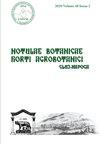The growth rate and genetic variability of Scots pine (Pinus sylvestris L.) half-sibs in test crops of Northern Kazakhstan
IF 1.3
4区 生物学
Q3 PLANT SCIENCES
引用次数: 0
Abstract
Scots pine (Pinus sylvestris L.) is a valuable tree species, playing an important role in maintaining the ecological and economic balance not only in Kazakhstan, but also in many countries around the world. The purpose of this study was to assess the growth rate and to identify the genotypes of the half-sib progeny of Scotch pine plus trees in order to further obtain high-quality seeds with valuable genetic traits. A molecular genetic analysis was carried out using six microsatellite and 20 isoenzyme loci on 15 Scots pine half-sib families, represented by two samples of seeds collected in the subsequent harvesting periods (planted in 1986 and 1987), that evaluated the taxonomic characteristics such as tree height and trunk diameter (DBH, measured at 1.3 meters). Families with the highest growth rate in both samples were selected as candidates for the elite group. During the SSR analysis, a decrease in the level of expected heterozygosity (0.2377-0.5362 with an average value of 0.4593) was observed in P. sylvestris L. half-sibs compared to the sample of maternal plus trees (0.5444), with similar results to that of the “founder effect”. At the same time, the level of observed heterozygosity remained sufficiently high (0.3333-0.7037 with an average value of 0.4980 and 0.4556, respectively). During the isoenzyme analysis, the level of genetic variability either decreased or was similar to that of the maternal trees. Rare and unique alleles were found in seed samples of the analysed tree families. In general, this research showed that a comprehensive evaluation combining both traditional breeding methods (genetic assessment of progeny in the course of growth) and molecular genetic analysis is required for the selection of elite trees.北哈萨克斯坦试验作物中苏格兰松(Pinus sylvestris L.)半兄弟的生长速率和遗传变异
苏格兰松(Pinus sylvestris L.)是一种珍贵的树种,在维护哈萨克斯坦乃至世界许多国家的生态和经济平衡中发挥着重要作用。本研究的目的是评估苏格兰松加树半同胞后代的生长速率和基因型,以进一步获得具有有价值遗传性状的优质种子。利用6个微卫星和20个同工酶位点对15个苏格兰松半同胞科进行了分子遗传分析,以随后收获期(1986年和1987年种植)收集的2个种子样本为代表,评估了树高和树干直径(DBH,测量值为1.3米)等分类特征。两个样本中增长率最高的家庭被选为精英群体的候选人。SSR分析结果表明,与母系正树(0.5444)相比,柽柳半姐妹的期望杂合度(0.2377 ~ 0.5362,平均值为0.4593)明显降低,与“founder效应”的结果相似。同时,观察到的杂合度保持了足够高的水平(0.3333-0.7037,平均值分别为0.4980和0.4556)。在同工酶分析中,遗传变异水平或降低或与母树相似。在所分析的树科种子样本中发现了罕见和独特的等位基因。总体而言,本研究表明,选择优良树种需要结合传统育种方法(生长过程中后代遗传评价)和分子遗传分析相结合的综合评价。
本文章由计算机程序翻译,如有差异,请以英文原文为准。
求助全文
约1分钟内获得全文
求助全文
来源期刊

Notulae Botanicae Horti Agrobotanici Cluj-napoca
PLANT SCIENCES-
CiteScore
2.70
自引率
0.00%
发文量
118
审稿时长
3 months
期刊介绍:
Notulae Botanicae Horti Agrobotanici Cluj-Napoca is a peer-reviewed biannual journal aimed at disseminating significant research and original papers, critical reviews and short reviews. The subjects refer on plant biodiversity, genetics and plant breeding, development of new methodologies that can be of interest to a wide audience of plant scientists in all areas of plant biology, agriculture, horticulture and forestry. The journal encourages authors to frame their research questions and discuss their results in terms of the major questions of plant sciences, thereby maximizing the impact and value of their research, and thus in favor of spreading their studies outcome. The papers must be of potential interest to a significant number of scientists and, if specific to a local situation, must be relevant to a wide body of knowledge in life sciences. Articles should make a significant contribution to the advancement of knowledge or toward a better understanding of existing biological and agricultural concepts. An international Editorial Board advises the journal. The total content of the journal may be used for educational, non-profit purposes without regard to copyright. The distribution of the material is encouraged with the condition that the authors and the source (Notulae Botanicae Horti Agrobotanici Cluj-Napoca or JCR abbrev. title Not Bot Horti Agrobo) are mentioned.
 求助内容:
求助内容: 应助结果提醒方式:
应助结果提醒方式:


